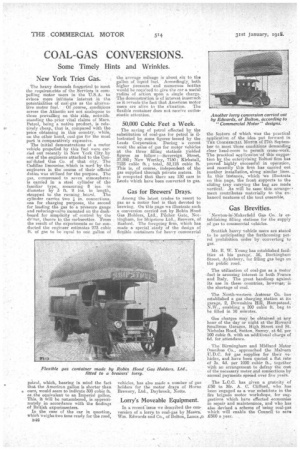COAL-GAS CONVERSIONS.
Page 20

If you've noticed an error in this article please click here to report it so we can fix it.
Some Timely Hints and Wrinkles.
New York Tries Gas.
The heavy demands fongpetroI to ineet the requiremehts of the Services is compelling motor users in the U.S.A. to evince more intinaate interest in the potentialities of coal-gas as the alterna
tive motor fuel. Of ,ceurse., conditions across the Atlantic are not analogous to those prevailing on this side, notwithstanding theprior vital claims of Mars. Petrol, being a native product, is relatively cheap, that is, compared With the price• obtaining in this country, while, on the other hand, coal-gas for the most part is comparatively expensive.
The initial demonstrations of a motor vehicle propelled by this fuel were carried out recently in New York City. by one of the engineers attached to the Consolidated Gas Co. of that city. The Cadillac limousine,tvhich is used by the engineers in the course of their official duties was utilised for the purpose. The gas, compressed to .seven atmospheres is carried in a steel cylinder of the familiar type, measuring8 iris, in diameter by 3 ft. 9 ins. in length,
strapped to the running., board. The cylinder carries two in. connections,
one for charging . purposes, the second for leading the gas to a pressure. gauge and reducingevalve Mounted on the dashboard for simplicity 'oCcontrol bythe driver, thence to the Carburetter. From the result of the experiments so. far conducted the engineer estimates 273 cubic ft. of gas to be 'equal to one gallon of
petrol, which, bearing in mind the fact that the American gallon is shorter than • ours, would seem to indicate 509 cubic ft. the equivalent to an Imperial gallon. This, it will be remembered, is approximately in -accordance with the findings of British experimenters. In the case of the car in question, which' weighs two tons ready for the road, is4a
the average mileage isabout six to the gallon of liquid fuel.. Accordingly, both higher Pressure.and numerous bottles would be reqUired to give the ear a useful radius of action: upon a single charge. The demonstration is of interest inasinuch. as it reveals the Tact that American motor
users are alive to the situation. The flexible container does not-receive enthusiastic afteution.
50,000 Cubic Peet a Week.
The saving of petrol effected by the i substitution of coal-gas for petrol s illustrated by. srome figures issued by the Leeds Corporation. During a recent week the sales of gas for motor vehicles at the three filling statioilli yielded figures as follow :—Sovereign Street, 37,850; New Wortley, 7150; Kirkstall, 7125 cubic ft. ; total, 52,125 cubic ft. This is, of course, independent of the gas supplied through private meters. It is computed that there are 150 cars in Leeds which have been converted to gas.
Gas for Brewers' Drays.
Among the latest trades: to resort to gas as a motor fuel is that devoted to brewing, On this page we illustrate such a conversion carried out by Robin Hood Gas Holders, Ltd., Pilcher Gate, Nottingham, for Shipstone Ltd., Brewers, of Ba.sford. The foregoing firm, which has made a special sturlY of the design of flexible containers for heavy come-H.1.6AI
vehicles, has also made a number of gas holders for the motor drays of Horne Brewery, Ltd., Daybrook, Notts.
Lorry's Moveable Equipment.
In a recent' issue we described the conversion of a lorry to coal-gas by Messrs: Wm. Edwards and Co., of Bolton, Lancs., the feature of which war the practical application of the idea put forward in Tun COMILF..RCIAL MOTOR Of 27th September to meet -those conditions demanding clear bead-room to permit crane-work. The practical application of this suggestion by the. enterprising Bolton firm has proved highly successful in operation, and recently this firm has carried out another installation, along similar lines. In, this instance, which `we illustrate on this page, the front Supports to the sliding tray carrying the hag are made vertical. As will be seen this arrangement contributes materially to the enhanced neatness of the tout ensemble.
Gas Brevities.
• -.Newton-iri-Makerfield Gas Co: is e.a-. tablishing filling stations for the supply of gas to commercial vehicles.
. Scottish heavy vehicle users are stated to be anticipating the forthcoming petrol prohibition order by converting to gas.
Mr, E. W. Young has established facilities at his garagO 56; Buckingham Street, Aylesbury, for filling as bags on the public road.
The, utilization of coal-gas as a motor
• fuel -is arousing interest in both France and Italy. The great handicap against. its use in these countries, hpwevur, is the shortage of coal.
The North-western, Autocar Co. has established a gag charging station at its garage, 2, Downshire Hill, Hampstead, enabling a 200 cubic ft. bag to he filled in 10 Minutes.
Gas charges may be obtained at any hour of the day or night at the Howard Sinallman Garages, High. Street and St. Nicholas Road, Sutton,•Surrey, at, 4d: per 100 cubic ft, with an additional charge of 6d. for.attendance.
• The Birmingham and Midland Motor Omnibus CO., approached the Malvern
• U.D.C. fol.' gas supplies for their vehicles, and have been quoted a flat rate of 3s. 4d. per MOO cubic ft., together m'rith an arrangement to defray the cost of the necessary meter and connections byannual payments spread over five" years.
The L.C.C. has given a gratuity of to Mr. A. C. Clifford, who has been engaged as a war substitute in the fire brigade motor workshops, for suggestions which have effected economies in repair and maintenancee and who hag also devised a scheme of using coal-gas which will enable the C.ourieil to save 5430 a year.
























